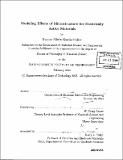Modeling effects of microstructure for electrically active materials
Author(s)
García Muñoz, Ramiro Edwin, 1972-
DownloadFull printable version (10.12Mb)
Other Contributors
Massachusetts Institute of Technology. Dept. of Materials Science and Engineering.
Advisor
W. Craig Carter.
Terms of use
Metadata
Show full item recordAbstract
A theoretical framework is proposed for the description of multifunctional material properties. The focus of this theory is on deriving equilibrium and kinetic equations for electrically active materials, particularly for rechargeable lithium-ion batteries and piezoelectric and electrostrictive microstructures. In both cases, the finite element method is applied to account for the effects of microstructure. Other derived equations that result from this theory are the wave equation in the limit of chemically homogeneous solids, and transport equations of charged species in conductive, non-polarizable, magnetic solids, as well as in polarizable non-magnetizable solids. The effects of microstructure in cathode materials for the Li[sub]yC₆/Mn₂O₄ rechargeable battery system are modeled, and several two-dimensional arrangements of particles are proposed to increase its power and energy density. Four ways are suggested to improve battery performance: controlling the transport paths to the back of the cathode, maximizing the surface area for intercalating lithium ions, engineering the porosity of the electrolyte phase, and distributing the lithium-ions evenly at the front of the cathode. The effects of grain size and crystallographic texture of piezoelectric and electrostrictive materials is simulated for BaTiO₃ and PZN-PT. Results show that the high anisotropy of the underlying single-crystal properties enhances the macroscopic piezoelectric response with respect to a single-crystal. For BaTiO₃, d₃₁ and d₃₃ are enhanced at the expense of the spatial contributions of d₁₅, and an optimal response is predicted for samples that are not perfectly textured. Similarly, for PZN-PT, an enhancement in d₁₅ is predicted. For cubic BaTiO₃, the low anisotropy of the underlying crystal structure induces a uniform decrease of the macroscopic electrostrictive constant Q₁₁.
Description
Thesis (Ph. D.)--Massachusetts Institute of Technology, Dept. of Materials Science and Engineering, 2003. Includes bibliographical references (leaves 141-150).
Date issued
2003Department
Massachusetts Institute of Technology. Department of Materials Science and EngineeringPublisher
Massachusetts Institute of Technology
Keywords
Materials Science and Engineering.